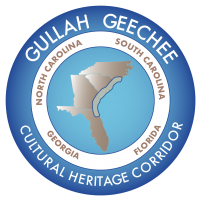About
The Gullah Geechee people are the descendants of Central and West Africans who came from different ethnic and social groups. They were enslaved together on the isolated sea and barrier islands that span what is now designated as the Gullah Geechee Cultural Heritage Corridor – a stretch of the U.S. coastline that extends from Pender County, North Carolina to St. John’s County, Florida and for 30 miles inland.
The result was an intense interaction among Africans from different language groups in settings where enslaved Africans and their descendants formed the majority. Over time, they developed the creole Gullah Geechee language as a means of comunicating with each other and they were also able to preserve many African practices in their language, arts, crafts and cuisine. LANGUAGE
Gullah is a unique creole language spoken along the Sea Islands and adjacent coastal areas of South Carolina and Georgia. The residents in Georgia are typically referred to as “Geechee.” Gullah language began as a simplified form of communication among people of different languages including European slave traders, slave owners and diverse African ethnic groups. The vocabulary and grammatical roots come from European and African languages. Gullah Geechee language is the only distinctly African creole language in the United States and has influenced traditional Southern vocabulary and speech patterns.
ARTS, CRAFTS AND MUSIC
Enslaved Africans brought a rich heritage of cultural traditions in art, food ways and music. Arts and crafts are the result of products designed by necessity for activities of subsistence and daily living such as making cast nets for fishing, basket weaving for agriculture and textile arts for clothing and warmth. The art of making casts for fishing has been passed down by enslaved Africans brought to the southeastern shores of the United States. Gullah Geechee people continue to use the nets to harvest from the Sea Island waterways, but the tradition is labor intensive and artists are dwindling in numbers as younger generations have lost interest. African textile traditions that included sewing strips of cloth into larger patterns were combined with European quilting methods and a creole art form emerged. Quilts with bright colors and designs were originally made for necessity. These traditions also allowed women a time for social interaction.
Sweetgrass baskets, originally designed for rice production and processing and other domestic uses in Africa, were used for agricultural purposes such as planting and harvesting of coastal crops. Made of bulrush, sweetgrass and split oak, the African art of basket making was significant as a traditionally passed down handicraft practiced by both men and women using similar materials from their homeland. Baskets also gained recognition for the skill of an artist and uniqueness in style. Even in historic times, baskets were sold to non-Gullah Geechee people and were a source of additional income.
African songs are the foundation for what may be referred to as Gullah music. Deeply rooted in music traditions brought to the Americas by enslaved Africans, the music evolved out of the conditions of slavery that characterized their lives. The influence and evolution of musical forms that arose out of Gullah music can be heard in many musical genres such as spirituals and gospel music, ragtime, rhythm and blues, soul, hip hop and jazz.
FOODWAYS
Food has always played an important role in social traditions in many cultures. Gatherings, celebrations, and religious rituals, are often accompanied by food. The Gullah diet consisted of items available locally such as vegetables, fruits, game, seafood, livestock; items imported from Europe, items imported from Africa during the slave trade (okra, rice, yams, peas, hot peppers, peanuts, sesame “benne” seeds, sorghum and watermelon), and food introduced by Native Americans such as corn, squash, tomatoes and berries. Rice became a staple crop for both Gullah and whites in the southeastern coastal regions. Although a bounty of food types existed, there was not always a bounty of food available for enslaved Gullah people or their descendants. Making use of available food (or rations), making a little go a long way, supplementing with fish and game, leftovers from butchering and communal stews shared with neighbors were African cultural practices.
African cooking methods and seasonings were applied in the Gullah homes and plantation kitchens. Because plantation cooks were primarily enslaved women, many of the African cooking traditions were employed along with creatively incorporating foods introduced by European, Spanish and American Indian influence, much of the food today referred to as “Southern” comes from the creativity and labor of enslaved African cooks from the plantations.
SPIRITUAL EXPRESSION
Religion and spirituality have a sustaining role in Gullah family and community life. Enslaved Africans were exposed to Christian religious practices in a number of ways and incorporated elements that were meaningful to them into their African rooted system of beliefs. These values included belief in a God, community above individuality, respect for elders, kinship bonds and ancestors; respect for nature, and honoring the continuity of life and the afterlife. Some plantation owners had regular religious services on the plantation and required slaves to attend. Some plantations had separate services for blacks with black preachers. Plantations frequently had a praise house or small structure where slaves could meet for religious services, but these also had significance in maintaining community cohesion, social structure and conflict resolution.

